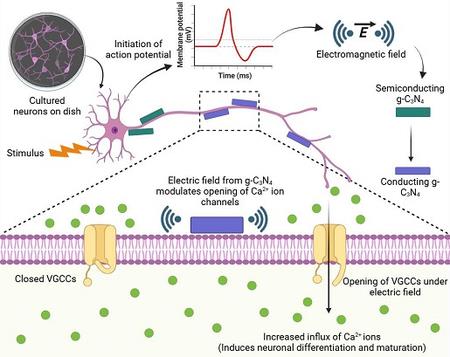INST Researchers Develop Nanomaterial That Stimulates Brain Cells Without Surgery
The discovery could transform treatment for brain disorders, said the team.
The special nanomaterial called graphitic carbon nitride (g-C3N4) can stimulate brain cells -- without the need for electrodes, lasers, or magnets.
The findings, published in the journal ACS Applied Materials and Interfaces, demonstrate that graphitic carbon nitride helps neurons grow, mature, and communicate more effectively by tapping into the brain's own electrical activity.
“This is the first demonstration of semiconducting nanomaterials directly modulating neurons without external stimulation,” said Dr. Manish Singh, who led the study from INST.
“It opens new therapeutic avenues for neurodegenerative diseases like Parkinson's and Alzheimer's,” Singh added.
The material also boosted dopamine production in lab-grown brain-like cells and reduced toxic proteins linked to Parkinson's disease in animal models.
Normally, treatments such as deep brain stimulation (DBS) require surgical implants, while other methods use magnetic or ultrasound waves to reach brain tissue. Although these are effective, they are also invasive or limited.
Graphitic carbon nitride, on the other hand, can“talk” to neurons naturally.
When placed near nerve cells, it generates tiny electric fields in response to the brain's voltage signals. These fields open calcium channels on neurons, triggering growth and improving connections between cells -- without any external device.
The material, acting like a smart switch, responds to neurons' resting and active states, creating the right conditions for healthy brain activity.
This biocompatible nanomaterial, with the ability to stimulate brain cells and reduce disease-linked proteins, offers a potential non-invasive therapy for millions.
The breakthrough could also impact futuristic technologies such as“brainware computing.”
Scientists worldwide are experimenting with brain organoids -- tiny lab-grown brain tissues -- as biological processors. Coupling them with semiconducting nanomaterials like g-C3N4 could make these living computers more efficient, opening new frontiers in bio-inspired computing.
The researchers pointed out that more preclinical and clinical studies are needed before human applications.
“We believe this marks a paradigm shift in neuromodulation research.“From treating brain injuries to managing neurodegeneration, semiconducting nanomaterials hold immense promise for the future,” Dr. Singh added.

Legal Disclaimer:
MENAFN provides the
information “as is” without warranty of any kind. We do not accept
any responsibility or liability for the accuracy, content, images,
videos, licenses, completeness, legality, or reliability of the information
contained in this article. If you have any complaints or copyright
issues related to this article, kindly contact the provider above.
Most popular stories
Market Research

- Kucoin Presents Kumining: Embodying Simple Mining, Smart Gains For Effortless Crypto Accumulation
- 1Inch Becomes First Swap Provider Relaunched On OKX Wallet
- Cregis Joins TOKEN2049 Singapore 2025
- Leverage Shares Launches First 3X Single-Stock Etps On HOOD, HIMS, UNH And Others
- Blockchainfx Raises $7.24M In Presale As First Multi-Asset Super App Connecting Crypto, Stocks, And Forex Goes Live In Beta
- BILLY 'The Mascot Of BASE' Is Now Trading Live On BASE Chain






















Comments
No comment